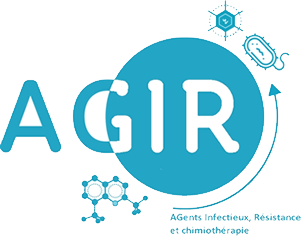ESKAPEE bacteria
You are here : Accueil > Research program > ESKAPEE bacteria
Enterococcus faecium, Staphylococcus aureus, Klebsiella pneumoniae, Acinetobacter baumannii, Pseudomonas aeruginosa, Enterobacter spp., Escherichia coli
Among the bacteria implicated in antibiotic resistance, a group of seven pathogens identified under the term ESKAPEE bacteria constitute a serious threat. These are Gram-positive (ESKAPEE) and Gram-negative (ESKAPEE) bacteria that cause many nosocomial infections. Thus, the pyocyanin bacillus (P. aeruginosa) is for example responsible for pulmonary, urinary and post-operative infections, but also for septicemia in immunocompromised patients, suffering from cystic fibrosis or severe burn victims.
However, the prodigious adaptation capacities of these bacteria have led to the development of sophisticated resistance mechanisms to antibiotics such as the appearance of a lack of penetration, particularly through the outer membrane of Gram-negative bacteria for antibiotics presenting a periplasmic or cytoplasmic target (e.g.: reduction in membrane permeability associated with a reduced number of porins), the acquisition of efflux systems and the modification of targets...
In this context, the AGIR laboratory is therefore interested in characterizing the resistance mechanisms of clinical strains resistant to fluoroquinolones:
- the overexpression of efflux pumps is thus sought phenotypically (Phenylalanine Arginine β-napthylamide efflux inhibitors), then confirmed genotypically by RT-qPCR,
- the search for mutations in the target of fluoroquinolones is carried out by sequencing the genes coding for topoisomerases as well as the search for Qnr proteins.
Then, our team also works on the development:
- analogs of siderophores (iron transporters), antibiotic vectors, capable of ensuring their increased internalization within the bacteria by countering resistance phenomena thanks to the implementation of a “Trojan Horse strategy” ,
- anti-virulence agents that inhibit bacterial “quorum sensing”, capable of attenuating the pathogenicity of P. aeruginosa without affecting its growth, notably by hindering the formation of biofilms,
- efflux system inhibitors (ISE),
- and new antibiotics.
The synthesized molecules are then tested on a set of wild or clinical strains, included in our biobank and all presenting a fluoroquinolone resistance phenotype, but with different mechanisms.
"The Trojan Horse strategy"





